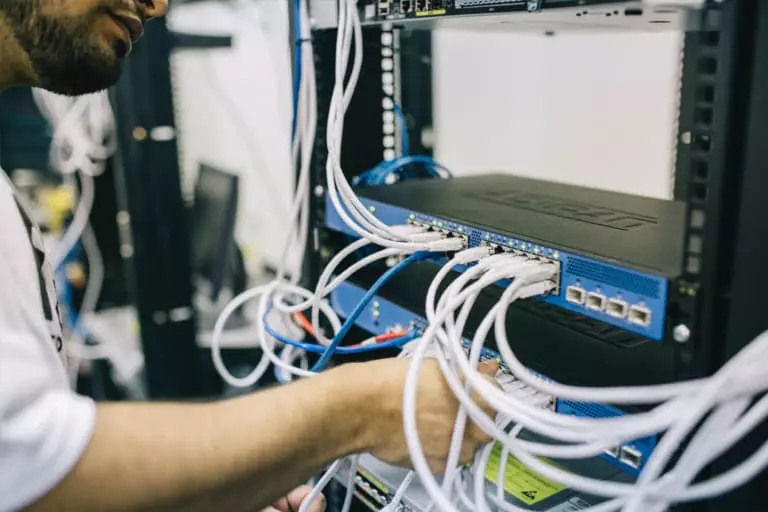Network Management
Dr. Lavian offers network management expert consulting services involving Network Management Systems (NMS), network device management, and network management of routers, switches, gateways, firewalls, MIBs, and SNMP. Network management includes the processes, tools, and applications used by the network administrator to administer, operate, troubleshoot, and maintain a communication network infrastructure. The acronym FCAPS is the OSI/ISO model for Network Management commonly considered to include the following five domains:
- Fault.
- Configuration.
- Accounting.
- Performance.
- Security
Network Management Technologies
Network management is the process of monitoring, configuring, and maintaining the performance and security of a computer network. Network management systems (NMS) are software applications that help administrators manage and monitor the health and performance of a network. One standard protocol used in NMS is the Simple Network Management Protocol (SNMP). SNMP sets standards for communication with devices on a network, such as routers, switches, and servers. It allows administrators to remotely monitor and manage network devices by sending and receiving messages, known as SNMP traps and SNMP requests, between the NMS and the network devices. SNMP can monitor the performance and status of devices and configure and update their settings. It is a vital tool in ensuring the reliability and efficiency of computer networks and the internet.
Network Management Expert
- Switches, routers, firewalls and VPNs, wireless controllers and access points, and servers.
- OSI/ISO FCAPS, Faults, Configuration, Accounting, Performance, and Security.
- LAN, WLAN, WAN, and VPN.
- L2/L3, SNMPv2, SNMPv3, Alarms, Alerts, Traps, RADIUS.
- DHCP, DNS, ARP, TCP/IP, sFTP, and Telnet.
- Syslog, NetFlow, sFlow, and IPFIX.
- FW Rules and ACLs.
- Topology maps, Reporting, and Capacity Planning.
- PCI, GDPR, ITIL, and HIPAA.
- ML and AI.

Wired and Wireless Networks
Wired and wireless
Networks are comprised of a collection of network equipment that interoperates together and transports data packets from one connection to another in the network. Network equipment may include some or all of the following types of networking gear: edge switches, aggregation switches, core switches, routers, firewalls and VPNs, wireless controllers and access points, and servers.
Each of these types has a different purpose:
Switches
Edge switches are typically L2 switches at the network’s edge. However, These are the switches to which user and IoT endpoint devices and wireless access points connect. High-rise office buildings with wiring closets on each floor are an apt analogy to help understand their function.
Aggregation switches
Aggregation switches are typically L2/L3 types. They connect to edge switches on one end and core switches on the other. The aggregation switches aggregate traffic from the edge and transport the data packets to the core switches. Therefore, Aggregation switches would typically be installed in each office building on campus to aggregate traffic from the entire building.
Core switches are typically L2/L3 switches connected to aggregation switches on one end and connected to the business enterprise’s router on the other end.
Routers
L3 routers perform the routing function of the campus, sending traffic outside the campus or routing internally to the appropriate destination, such as application servers. Moreover, Routers are, on one end, typically connected to the core switches and, on the other, connected to the Internet through a service provider service.
Firewalls and VPNs
Firewalls and VPNs are part of the security layers of any network. They are critical for protecting the network and business resources against hackers and malicious activities. Other security equipment includes NAC (Network Access Control), IDS/IPS (Intrusion Detection and Prevention), Content Filtering, and more. Organizations choose to deploy security layers based on budgets and needs; however, firewalls and VPNs are the most often deployed.
Wireless Controllers
Wireless Controllers and Access Points comprise the enterprise wireless network overlay over the wired network. These wireless access points connect the network to mobile and stationary users and IoT devices. Access points are typically connected to the edge switches and distributed across the campus indoors and outdoors. Therefore, Enterprises are moving toward increased wireless connectivity and decreased wired connectivity. Their approach determines by the IT department based on the nature of the business enterprise.
Servers
Servers are not part of the network but are the resources utilized by users’ applications and monitored by network management.
There are four types of networks:
LAN – Local Area Network (LAN) is the typical wired network in the office campus.
WLAN – Wireless Local Area Network (WALN) is a wireless overlay on the wired network.
WAN – Wide Area Network (WAN) is the network traffic from one enterprise campus traverses to get to another campus.
VPN – Virtual Private Network (VPN) is a secure network over which encrypted tunneling carries traffic from employees at home or one campus to another across the Internet.